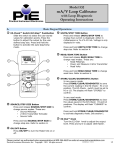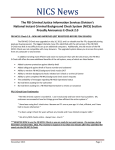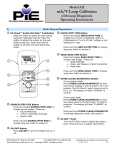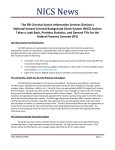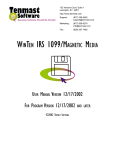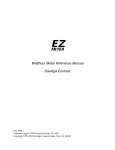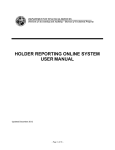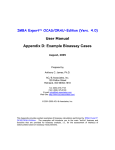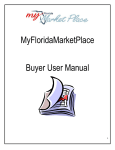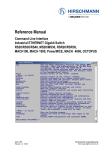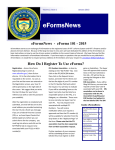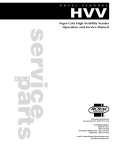Download May 2012 - Bureau of Alcohol, Tobacco, Firearms and Explosives
Transcript
U. S. Department of Justice Bureau of Alcohol, Tobacco, Firearms and Explosives FFL NEWSLETTER FEDERAL FIREARMS LICENSEE INFORMATION SERVICE May 2012 In an effort to keep Federal firearms licensees (FFLs) abreast of changing firearms laws and regulations, the Bureau of Alcohol, Tobacco, Firearms and Explosives (ATF) will provide semiannual FFL Newsletters. Previous editions of the FFL Newsletters are available on ATF’s Web site (http://www.atf.gov). What’s in This Issue Customer Service Standards SHOT Show 2012 Multiple Trade Name Policy Hunting Licenses Issued by Retailers Binary Exploding Targets Completion of Section A of ATF Form 4473 Out-of-State Driver’s License Used as an Identification Document to serve the needs of the law enforcement community first, to include ATF, other Federal agencies, and State and local law enforcement entities. We attempt to balance and address exigent circumstances—which the requestor shall articulate in writing and include with the original request—with the routine needs of all firearms and explosives industry members. This customer service goal applies to all the branches of Firearms and Explosives Industry Division—Firearms Technology Branch, Firearms Industry Programs Branch, and Explosives Industry Programs Branch. REAL ID Act of 2005 Recording Firearms in the Acquisition and Disposition Record Guide to Requesting Marking Variances Firearms Commerce in the United States 2011 Looking for Past Newsletters? FBI NICS Information Customer Service Standards It is the goal of the Firearms and Explosives Industry Division (FEID) to respond to requests from firearms and explosives industry members within 90 days of receipt. Requests may include variances, determinations, classifications, and exemptions. Please be aware that although we generally complete requests sooner than our 90 day goal, our ability to respond to industry-related inquiries is impacted by a number of factors, such as available staffing resources, the sufficiency of information received from the requestor, existing precedent for granting the request, necessary technical research and/or testing, and any applicable legal review process. Additionally, it is Firearms and Explosives Industry Division’s priority SHOT Show 2012 ATF has been participating at the annual SHOT Show for over 25 years. Our informational booth and subject matter experts serve industry members attending SHOT in several different ways. We conduct informational seminars on several topics, provide timely information on regulatory matters, and distribute ATF publications and forms to thousands of Federal firearms licensees who attend the event. ATF hosted an information booth, staffed by technical experts, to address questions from attendees. Additionally, ATF hosted a town hall meeting to formally address a variety of current issues affecting FFL business operations and to inform FFLs of upcoming projects. This edition of the FFL newsletter will highlight this year’s event and provide information to those licensees who were not there with our participation. ATF presentations included: Inspection Findings was presented by Deputy Assistant Director (Field Operations, IO) Harry McCabe on January 18, 2012. This presentation covered the most frequently cited firearms violations and how to ensure compliance with Federal firearms laws and regulations. May 2012 FFL NEWSLETTER ATF will accept applications from legal entities wishing to establish separate FFLs for each trade name it uses at a single location. However, ATF will also accept applications from legal entities wishing to obtain just one FFL for a licensed premise at which multiple trade names will be used. The presentation can be found at: http://www.atf.gov/firearms/industry/011812-industry-operation-inspection-results-presentation.pdf Detecting and Avoiding Illegal Straw Purchases was presented by Las Vegas Field Office Resident Agent in Charge (RAC) Thomas Chittum on January 19, 2012. RAC Chittum reviewed some common scenarios used by straw purchasers to illegally obtain firearms for others who may be prohibited, as well as discussed some common questions to ask to insure the buyer is the actual purchaser. The presentation can be found at: http://www.atf.gov/publications/firearms/SHOT%20Show %202012/011912-detecting-avoiding-illegal-straw-purchases. pdf A legal entity must obtain FFLs for each location at which it operates a firearms business. For example, if your company has three different manufacturing facilities, you will need a manufacturing license for each location. If you manufacture and import, you will need both a Type 07—Manufacturer and Type 08—Importer license to be properly licensed, even if operations are performed at the same facility under the same trade name. ATF Inside and Out was presented by Chad Yoder, Chief, Firearms and Explosives Industry Division on January 19, 2012. Chief Yoder provided information to acquaint licensees with many of the ATF resources and tools available. Additionally, Chief Yoder discussed who to contact for information and how to get answers to questions covering a variety of topics. The presentation can be found at: http://www.atf. gov/firearms/industry/011912-atf-inside-and-out.pdf It is also important to remember that manufacturers and importers having licensed operations at one location under multiple trade names are still required to issue individual serial numbers when marking firearms pursuant to 27 CFR 478.92. For example, serial numbers and serial number schemes applied to firearms made or imported under trade name A must not duplicate serial numbers applied to firearms made or imported by the same company under trade names B, C, or D. Additional information pertaining to ATF’s involvement in the 2012 SHOT Show can be found at: http://www.atf.gov/firearms/industry/shot-show-2012.html The only limit to the number of trade names that can be assigned to a single FFL is system capacity. ATF’s licensing database cannot currently accommodate more than 50 characters in the trade name field. The Federal Firearms Licensing Center (FFLC) can work with you to construct a multiple trade name scheme for your FFL that fits within these parameters. Please keep in mind that the FFLC or your local ATF office may request verification of your legal right to use a particular trade name before issuing a license bearing that name. Multiple Trade Name Policy ATF has recently clarified its trade name policy to allow a single legal entity to maintain several different trade names on its Federal firearms license (FFL). Prior to this it was ATF practice to allow only one trade name per legal entity on a FFL. Under the old policy, if a legal entity wished to brand its firearm product using multiple trade names, it would have to create several different firearms manufacturing or importing companies, each with a different trade name, Employer Identification Number, and FFL for the same location. Hunting Licenses Issued by Retailers Questions have arisen as to whether a hunting license or permit issued by a retail store qualifies as a government issued identification document that can be used as a supplement to another government issued identification document. ATF’s current policy allows a licensee wishing to use multiple trade names to apply for just one license and list all applicable trade names on the license application. This helps streamline the licensing process by reducing the number of licenses an industry member and ATF must renew, amend, keep records for, and inspect. An identification document is defined as a document containing the name, residence address, date of birth, and photograph of the holder and which was made or issued by or under the authority of the United States Government, a State, political subdivision of a State, a foreign government, political subdivision of a foreign May 2012 FFL NEWSLETTER (e.g., personal target practice) are not required to have a Federal explosives license or permit. However, individuals or companies must obtain a Federal explosives manufacturing license if they intend to engage in the business of manufacturing explosives for sale or distribution, or for their own business use. Such business uses include manufacturing binary targets for demonstration or product testing purposes. government, an international governmental or an international quasi-governmental organization which, when completed with information concerning a particular individual, is of a type intended or commonly accepted for the purpose of identification of individuals (27 CFR 478.11). As outlined in ATF Rul. 2001-5, licensees may accept a combination of valid government-issued documents to satisfy the identification document requirements of the Brady Act. The required valid government-issued photo identification document bearing the name, photograph, and date of birth of the transferee may be supplemented by another valid, government-issued document showing the transferee’s residence address. Licensed manufacturers of exploding targets are subject to Federal recordkeeping requirements and must comply with regulations concerning records of manufacture or acquisition, distribution, exportation, use, inventory and daily summaries of magazine transactions found in 27 CFR, Part 555, Subpart G—Records and Reports. In addition, a Federal explosives license or permit is required for the transport of explosive materials. Therefore, a person must obtain a Federal explosives license or permit if they mix binary exploding targets and subsequently transport them to a shooting range or to any other location. Whether a hunting license or permit issued by a retailer meets the definition of an identification document is State law specific. This license or permit meets the definition of an identification document if the State in which the retailer is located has authorized the retailer to supply State issued documents. If the State recognizes the hunting license or permit as government issued, then this license or permit would qualify as being government issued for the purposes of supplementing another government issued identification document. For further information, please contact the Explosives Industry Programs Branch at [email protected] or 202-648-7120. Completion of Section A of ATF Form 4473 Binary Exploding Targets ATF has recently received inquiries about the applicability of the Federal explosives law to binary exploding targets. The components of these binary targets (typically an oxidizer like ammonium nitrate and a fuel such as aluminum or another metal based powder) are not separately listed on the List of Explosive Materials and do not meet the definition of “Explosives” in 27 CFR 555.11. Therefore, ATF does not regulate the sale and distribution of these component chemicals, even when sold together in binary target “kits.” ATF has recently received inquiries regarding who may assist a buyer that is unable to read and/or write in the completion of an ATF Form 4473. Federal firearms licensees (FFL) have asked for clarification of the term “seller”. The buyer must personally complete Section A of the ATF Form 4473 and certify (sign) that the answers are true, correct, and complete. However, if the buyer is unable to read and/or write, the answers (other than the signature) may be completed by another person, excluding the seller. Two persons (other than the seller) must then sign as witnesses to the buyer’s answers and signature. However, when the binary components are combined, the resulting mixture is an explosive material subject to all requirements of 18 U.S.C. Chapter 40 and 27 CFR Part 555. Accordingly, all such exploding targets must be stored in an explosives storage magazine as prescribed in the regulations found in 27 CFR, Part 555, Subpart K—Storage, unless they are in the process of being used. ATF considers the term “seller” as any employee of the FFL. Therefore, no employee of the FFL (whether directly assisting the buyer or not) may assist the buyer with the completion of the ATF Form 4473 or sign as a witness to the buyer’s answers and signature. Further, mixing the binary components together constitutes manufacturing explosives. Persons manufacturing explosives for their own personal, non-business use only May 2012 FFL NEWSLETTER Please note that in August 2010, ATF published the ATF P 5300.15, Federal Firearms Licensee Quick Reference and Best Practices Guide. Within the guide is a section titled, “Military members… may have special identification document considerations.” The section states, in part, that “No additional valid identification documentation is required of an active-duty member of the Armed Forces… if he or she possesses a valid identification document (e.g., driver’s license) that contains his or her name, residence address, date of birth, and photograph and is issued by the State in which your business premises is located.” Out-of-State Driver’s License Used as an Identification Document ATF has received questions from Federal firearms licensees (FFLs) regarding the acceptance of an out-of-state driver’s license that shows a current in-state residence address. For example, a purchaser who is in the military may have an Oklahoma driver’s license that shows a current Virginia residence address. The Brady Act requires FFLs to identify the nonlicensed transferee by examining a valid government-issued identification document that contains the photograph of the holder. 18 U.S.C. 922(t)(1)(C). This requirement applies to all over-the-counter transfers, even where the transferee holds a permit that qualifies as an exception to the requirement for a NICS check at the time of transfer. 27 CFR 478.124(c)(3)(i). Please note that this guidance is only a recommendation. Under Federal law, it is not required that the valid identification document be issued by the State in which your business premises is located. REAL ID Act of 2005 The Brady Act incorporates the definition of an “identification document” provided by 18 U.S.C. 1028(d)(3), which is set forth in relevant part as follows: Several states, including the District of Columbia, Puerto Rico, the Virgin Islands, Guam, American Samoa, and the Commonwealth of the Northern Mariana Islands, are implementing the REAL ID Act of 2005, Title II of division B of Pub. L 109-13, 49 U.S.C. 30301 (“REAL ID Act” or “Act”), which requires a driver’s license (DL) or identification card (ID) issued by a State to meet minimum requirements for Federal official purposes. As a result of the Act, these States are offering new DLs and IDs to customers with a marking (i.e. gold star, different color, lettering or format) on Act compliant DLs and IDs. The purpose of the marking is to assist with the recognition of such documents as compliant with the REAL ID Act, when presented for official purposes. The REAL ID Act defines “official purpose” as accessing Federal facilities, boarding Federally-regulated commercial aircraft, and entering nuclear power plants. Please note that different states may use different means to identify a compliant card from a non-compliant card. Furthermore, if a person refuses to provide additional documentation required under the new licensing requirements, the State will still issue a DL or ID; however, it will not have the REAL ID Act compliant marking and will not be valid for Federal official purposes as defined by the REAL ID Act. [A] document made or issued by or under the authority of the United States Government, a State, political subdivision of a State,… a foreign government, political subdivision of a foreign government, an international governmental or an international quasi-governmental organization which, when completed with information concerning a particular individual, is of a type intended or commonly accepted for the purpose of identification of individuals. ATF regulations further require that the identification document must contain the name, residence address, date of birth, and photograph of the holder (27 CFR 478.11). An out-of-state driver’s license with the purchaser’s current in-state residence address may be used to satisfy the Brady Act’s requirement for an identification document, provided that the driver’s license is valid and it contains the name, current in-state residence address, date of birth and photograph. However, if a licensee has reasonable cause to question the validity of an identification document, he or she should not proceed with the transfer until those questions can be resolved. In addition, you may refer to ATF Ruling 2001-5, Identification of Transferee, (http://www.atf.gov/regulations-rulings/rulings/atf-rulings/atf-ruling-2001-5.html) for additional information. May 2012 FFL NEWSLETTER Question #1: An unlicensed person wishes to purchase a firearm from a Federal firearms licensee (FFL) in a State that has adopted the REAL ID Act. The unlicensed person presents a DL that is marked across the face of the license in capital letters, “This Driver’s License Is Not Valid for Federal Identification Purposes.” Is such DL an “identification document” that an FFL may utilize for identifying the purchaser in accordance with the Brady Law, 18 U.S.C. 922(t)? Recording Firearms in the Acquisition and Disposition Record The Gun Control Act of 1968 (GCA) requires Federal firearms licensees (FFLs) to maintain records of their acquisitions and dispositions of firearms, to include complete and accurate descriptions of the firearms. One of the principal objectives of the GCA is to facilitate the tracing of firearms used in crime to provide support to Federal, State, and local law enforcement officials in their fight against crime and violence. The serial number, along with other required markings such as caliber, model, name of manufacturer, and city and State of the manufacturer or importer make any given firearm uniquely identifiable and traceable. Without accurate identification of these firearms, law enforcement officials face considerable obstacles in investigating crimes involving firearms. Answer #1: Yes, provided the DL or ID meets the requirements set forth by the Gun Control Act (GCA) and its implementing regulations. If the DL or ID meets the definition of “identification document” as defined in 18 U.S.C. 1028(d) and 27 C.F.R. 478.11, it would be acceptable for purposes of the firearm transfer. 27 CFR 478.11 defines the term identification document as: “A document containing the name, residence address, date of birth, and photograph of the holder and which was made or issued by or under the authority of the United States Government, a State, political subdivision of a State, a foreign government, political subdivision of a foreign government, an international governmental or an international quasi-governmental organization which, when completed with information concerning a particular individual, is of a type intended or commonly accepted for the purpose of identification of individuals.” To accurately identify a firearm, FFLs receiving firearms must record the serial number in their acquisition and disposition (A&D) record. Be careful to use the number on the frame or receiver. Parts of the firearm, such as the slide or barrel, may be marked with a part or model number, different from the serial number. The following additional information must be marked on the frame, receiver, or barrel of post-1968 firearms, and must be recorded in the A&D record: model (if such designation has been made by the manufacturer); caliber or gauge; name of the manufacturer (or recognized abbreviation); and importer (if applicable). Please note that the identification verification requirement to transfer a firearm is not considered an “official purpose” under the REAL ID Act. The Act defines “official purpose” as accessing Federal facilities, boarding Federally-regulated commercial aircraft, and entering nuclear power plants. FFLs are required to enter both the manufacturer and importer (if any) in the A&D record. While the specific format required in 27 CFR 478.125(e) does not match the exact wording of the regulation, a licensed dealer is still required to record both, because that information is spelled out specifically in the wording of the regulation. Question #2: Can a DL or ID containing a REAL ID Act compliant marking (i.e. gold star, different color, lettering or format) be used as an alternative to the National Instant Criminal Background Check System (NICS)? All information to be recorded in the A&D record should be derived from the markings on the firearm. If a firearm is marked with two manufacturer’s names, or multiple manufacturer and importer names, FFLs should record each manufacturers’ and importers’ name in the A&D record. Answer #2: No, A DL or ID containing a REAL ID Act compliant marking is not an alternative to NICS. Only those permits that the Bureau of Alcohol, Tobacco, Firearms and Explosives (ATF) recognizes as qualified alternatives to the background check required under the Brady Law may be utilized as an alternative to NICS. ATF’s recognition of these permits as a Brady alternative is based on the fact that the State conducted background checks through NICS prior to the issuance or renewal of these permits, and denied a permit to anyone prohibited under Federal, State, or local law. May 2012 FFL NEWSLETTER 2. Identify the manufacturer whose markings will be placed on the firearm frame or receiver Guide to Requesting Marking Variances • Name as listed on FFL; you can use either: Licensed manufacturers and importers are required to mark firearms manufactured or imported with specific identifying information. This information is found under Title 18 (U.S.C. Section 923(i) and 27 CFR Section 478.92. However, the Bureau of Alcohol, Tobacco, Firearms and Explosives (ATF) Director may authorize other means of identification upon receipt of a letter application from licensed manufacturers and/or importers, showing that such other identification is reasonable and will not hinder the effective administration of the law. • Licensee name • Business name (e.g., trade name, etc.), if provided on FFL • Address • City • State (Only abbreviations recognized by the USPS will be accepted) • FFL number 3. Identify any other participants in the manufacturing process Purpose and Background Generally, each manufacturer of firearms is required by law to place identifying markings on the frame or receiver of every firearm that they manufacture. Marking variances are necessary when a licensed manufacturer of firearms intends to manufacture and mark firearms on behalf of another licensed manufacturer. In these instances, the contracted manufacturer places on the frames or receivers the required identifying markings for the manufacturer of record per 27 CFR Section 478.92. • Name as listed on FFL, can use either: • Licensee name • Business name (e.g., trade name, etc.), if provided on FFL • Address • City • State (Only abbreviations recognized by the USPS will be accepted) ATF is providing firearms manufacturers with guidance on the requirements for submitting requests for marking variances. This article communicates the information that must be submitted with your application in order for ATF to consider your request. You must send the letter of application for a marking variance with the following information to the ATF Firearms Technology Branch (FTB): • FFL number • Describe the manufacturing process to be completed by each additional participant 4. Identify the model of firearm, if designated 5. Identify the caliber or gauge 6. Identify the serial number(s) and/or range to be used 1. Identify the actual manufacturer of the firearm frame or receiver • • Name as listed on Federal Firearms License (FFL); you can use either: • Licensee name or Serial number range must not duplicate serial numbers appearing on any other firearms produced by or for the manufacturer identified above in step 2. 7. Identify where the firearm frames or receivers are shipped and/or transferred to between all of the manufacturers identified in the marking variance process. • Business name (e.g., trade name, etc.), if provided on FFL • Address 8. Provide a statement communicating the function of the firearm (semiautomatic, bolt-action, etc.) • City • State (Only abbreviations recognized by the U.S. Postal Service (USPS) will be accepted) 9. Provide contact information: phone number, e-mail address, business address of the requestor • Complete FFL number 10. Include drawing/schematic/photograph of firearm to be manufactured, displaying proposed markings • Describe the manufacturing process to be completed May 2012 FFL NEWSLETTER commodities. ATF is responsible for enforcing the Gun Control Act of 1968, as amended (GCA). The GCA regulates the manufacture, importation, distribution, and sale of firearms, and it contains criminal provisions related to the illegal possession, use, or sale of firearms. ATF also administers the National Firearms Act (NFA), which requires the registration of certain weapons, such as machineguns and destructive devices, and imposes taxes on the making and transfer of those weapons. • Illegible markings will not be accepted and will delay the marking variance process 11.Include a copy of the FFL for each manufacturer 12.Include, if applicable, a copy of the Special (Occupational) Tax Stamp for each manufacturer If a manufacturer has any proprietary concerns regarding disclosing the identity of any of the participating secondary manufacturers to the other secondary manufacturers contracted to perform work on the firearms, the manufacturer may submit individual requests to ATF. The letter must indicate separately each secondary manufacturers participating in the manufacturing process. ATF will address each request in a separate marking variance approval to ensure that the identities of the secondary manufacturers are kept proprietary. The Report contains information about domestic firearms manufacturing, importation of firearms, and exportation of firearms. It also provides an update on certain ATF regulatory initiatives, including our collaboration with the firearms industry, to improve compliance with Federal firearms laws and to prevent the diversion of firearms to illegal markets. Further, it furnishes select data sets regarding domestic firearms manufacturing, and the importation and exportation of firearms. Methods of Submission Electronically (preferred method): marking_variances@ atf.gov Fax: (304) 616-4301 Mailing Address: To read the full report, please go to: http://atf.gov/publications/firearms/121611-firearms-commerce-2011.pdf ATF, Firearms Technology Branch 244 Needy Road Martinsburg, WV 25405 Looking for Past Newsletters? In an effort to keep FFLs abreast of changing firearms laws and regulations, ATF provides ready access to FFL Newsletters. Previous editions of the FFL Newsletters are available on ATF’s internet site at: http://www.atf. gov/publications/newsletters/ Firearms Commerce in the United States 2011 The purpose of the Firearms Commerce Report is to provide an overview of firearms commerce in the United States and the role of the Bureau of Alcohol, Tobacco, Firearms and Explosives (ATF) in regulating firearms May 2012 FFL NEWSLETTER FBI NICS Information The FBI Criminal Justice Information Services Division’s National Instant Criminal Background Check System (NICS) Section would like to advise you of the many tools we have developed at the request of firearm dealers to improve their NICS experience: In Motion” walks the FFL and their employees through the NICS background check process and provides other valuable information. View the “NICS Process In Motion” at the FFL-dedicated Web site or call the FFL NICS Liaison Specialist at 1-877-FBINICS (324-6427), extension 57387. Two Is Better than One—Enroll with the NICS and the NICS E-Check New! FFL-Dedicated Web site http://www.fbi. gov/about-us/cjis/nics/federal-firearms-licensees: This Web site was developed with the Federal Firearms Licensee (FFL) in mind. Have questions or need additional information about the NICS process? The FFL-dedicated Web site is where to go. Once on the Web site, the FFL will have access to a wealth of information on FFL Enrollment, the NICS E-Check Process, Appeals, the Voluntary Appeal File (VAF) Process, the FFL NICS User’s Manual, and more! Try it out! Use it daily! Make it a desktop shortcut! When an FFL enrolls with the NICS Section, they are automatically enrolled to conduct their NICS background checks via the telephone with the NICS Contracted Call Centers. What if there was another option? Aren’t two options better than one? Well, it’s your lucky day! The NICS Section has a solution. A simple enrollment is all it takes to be able to add the ability to conduct your NICS background checks via the Internet with the NICS E-Check. In addition, the FFL does not have to be a computer wiz to complete a NICS E-Check transaction. Visit the NICS FFL Web site and check out all the NICS E-Check enrollment information. NICS Resolution Card for Your Extended Delayed or Denied Customers The NICS Section has noticed an increased propensity for a denied or delayed customer to be unsure about the best avenue to pursue when receiving extended delays or denied responses from their NICS background check. In reply, the NICS Resolution Card has been created. The purpose of this card is two-fold: (1) to define the most appropriate action for the customer to pursue; and (2) to educate and encourage customers to utilize the NICS Web site. Customers who initiate their inquiry through the NICS Web site will experience an improved userfriendly, streamlined process. The NICS Resolution Card can also be viewed on the NICS FFL Web site. To have the NICS Resolution Cards mailed to you, call the NICS Customer Service at 1-877-FBI-NICS (324-6427). General NICS Reminders for the FFL NICS Cannot Provide Your Customer the Reason For Their Delay or Denial Over the Phone Due to the Privacy Act of 1974, the NICS Section cannot provide the reason for your customer’s delay or denial over the telephone. If a prospective transferee has had extended delays or has been denied the transfer of a firearm, the FFL should give the individual a NICS Resolution Card. The FFL should circle the word DELAY or DENIED on the top portion of the card and write the NICS Transaction Number on the line provided on the bottom portion of the card. The NICS Resolution Card directs the customer to the NICS Appeal Web site http://www.fbi.gov/about-us/ cjis/nics/appeals/nics-appeals-process/appeals-home for customers to begin their VAF or appeal process. For customers without Internet access, they may contact the NICS Section’s Customer Service at 1-877-FBI-NICS (324-6427) for a packet to be sent via U.S. mail. “NICS Process In Motion” The NICS Section is always open to suggestions and comments. A suggestion was made by an FFL to make an animated video/flow chart for the FFL user to guide them through the NICS process. This animated video does exactly that. The “NICS Process May 2012 FFL NEWSLETTER FBI/NICS News (cont’d.) A NICS Web Site for Appeal and VAF Applicants there are two agencies to contact: the ATF Licensing Center at 1-866-662-2750, and the NICS Section’s Customer Service at 1-877-FBI-NICS (324-6427), option 2. The NICS Section deployed a Web site last spring for customers wishing to appeal a denied transaction or submit a VAF application on a delayed transaction. All electronically submitted appeal requests must be made through the NICS Appeal Web site at http:// www.fbi.gov/about-us/cjis/nics/appeals/nics-appealsprocess/appeals-home. The NICS appellant or VAF applicant will need to follow the step-by-step instructions on how to submit an appeal or VAF request. An Appeal or VAF Request Form must be completed with all mandatory fields prior to being able to print or electronically submit the request. FFL Validating Another FFL for a Firearm Transfer It is not the practice of the NICS Section to provide information that is ATF-related. If an FFL is attempting to verify another FFL’s license for a transfer, the FFL should access the ATF Web site at http://www.atf. gov/applications/fflezcheck/ or call the FFL ezcheck number at 1-877-560-2435. Common Mistakes/Discrepancies Made by the FFL and/or Purchaser Note: The NICS Resolution Cards are to be provided to your customer as informational purposes for appealing or submitting a VAF application. These cards are not to be sent into the NICS Section to initiate the Appeal or VAF Process. The following are common mistakes/discrepancies made by the FFL and/or purchaser. Please review the bullets below to make sure you are in compliance with the law. • Conducting a NICS check on a known straw purchase NICS E-Check Digital Certificate Expiration Date • ATF Form 4473 lost or not on file Attention FFL NICS E-Check Users: The NICS Section sends a reminder to renew your NICS ECheck digital certificate via e-mail 7, 15, and 30 days prior to the expiration date of the digital certificate. If you have not received these notices in the past, you may want to check your spam e-mail. Also, in order to receive these reminders, it is very important to keep your e-mail address up to date with the NICS Section. The NICS Customer Service Representatives are available to assist in updating your e-mail address in our records and/or additional questions concerning the NICS E-Check Digital Certificate by calling 1-877-FBI-NICS (324-6427), and selecting option 3. • FFL conducting a NICS check on a nonpurchaser • Transfer of a firearm prior to allowable NICS transfer date • No NICS check conducted • FFL calling in numerous checks on a denied individual (must be same contact at FFL and within same time period) • Modification of descriptive data to receive a proceed response from the NICS • Unauthorized access to the NICS • Duplicate NICS checks being performed • Not recording status updates from the NICS on the ATF Form 4473 Please Keep Your FFL Contact Information Up to Date If the NICS Section needs to contact your business, do we have the correct contact information on file for you? When your FFL contact information changes, May 2012 FFL NEWSLETTER FBI/NICS News (cont’d.) Where Do You Mail Your ATF Form 3310.4, Report of Multiple Sale or Other Disposition of Pistols and Revolvers? should be sent. Section 6a advises that a copy of the form should be submitted to the National Tracing Center no later than the close of business on the day the multiple sale or other disposition occurs. The form can be provided in a couple different ways. It can either be faxed to 877-283-0288, or mailed to the U.S. Department of Justice, Bureau of Alcohol, Tobacco, Firearms and Explosives, National Tracing Center, P.O. Box 0279, Kearneysville, WV 25430-0279. The NICS Section has been receiving numerous ATF Form 3310.4 erroneously at their address in Clarksburg, West Virginia. The ATF Form 3310.4 provides instructions on the back of the form regarding where this information 10










